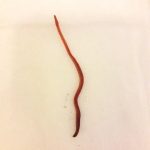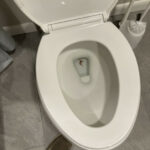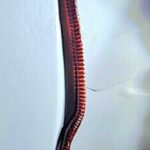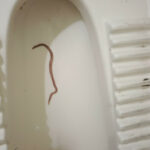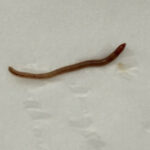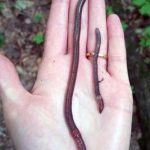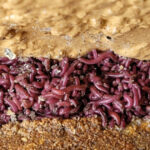
“In addition to, thankfully, lots of earthworms, I often find small worm-like creatures in my (UK) home-made compost (see picture, which I will hopefully be able to attach)”, writes John in his submission regarding the tiny, cream-white and brown, worm-like creatures pictured below. “These are about three quarters to one inch long. What are they, and will they harm plants? Many thanks if you’re able to reply.” Upon zooming in on these critters, we can see that their bodies are segmented and that tiny antennae sprout from their heads. This fact, coupled with the shape of their bodies and the location in which they were found tells us that John has found millipedes.
Millipedes are not harmful to plants, but are in fact helpful to them, much in the same way that earthworms are. The process is quite similar, on the surface. Millipedes, like earthworms, eat decomposing organic matter, and by the process of digestion and excretion, they produce nutrient-rich waste which they return to the earth as a natural fertilizer. Unlike earthworms though, millipedes are not worms but are arthropods: a phylum of organisms which can be distinguished by their segmented bodies which have pairs of legs sprouting from each segment. They also possess exoskeletons which protect the soft insides of their bodies, while worms are completely exposed and are thereby pretty fragile creatures.
Likewise, millipedes are not harmful to humans. The most they can do is secrete a smelly liquid which could potentially cause some irritation if it makes contact with bare skin. Millipedes also have a tendency to infest homes, though this is more typical in the hotter seasons when the climate outside becomes too hot and dry, where millipedes prefer cool and moist ones. They will then escape into people’s basements and garages if possible, though many of them will just pile up on people’s patios and dry out before they make it inside. Of course, John found these in his compost, and though there is something to be said about ‘too much of a good thing’ — and John will have to determine if there are too many of them based on the size of his compost bin — their presence should not be harmful. For the reasons we have listed above, they may just be beneficial to John’s compost!
In conclusion, the worms John found in his compost are actually not worms, but millipedes. They are harmless critters which are a service to soil systems, so we do not think John has anything to worry about here. However, if their numbers grow too big and they start competing with the other worms in his compost bin, then they might be something to worry about. John will just have to determine this for himself. We hope this helps, and we wish John the very best.
All About Worms is always free, always reader-supported. Your tips via CashApp, Venmo, or Paypal are appreciated! Receipts will come from ISIPP Publishing.
You might also find these guys interesting!




